Mindfulness practices, including meditation and yoga, can be powerful tools for managing panic attacks by fostering relaxation and grounding individuals in the present moment. Techniques such as focused breathing and body awareness not only help reduce anxiety symptoms but also empower individuals to regain control during distressing episodes.
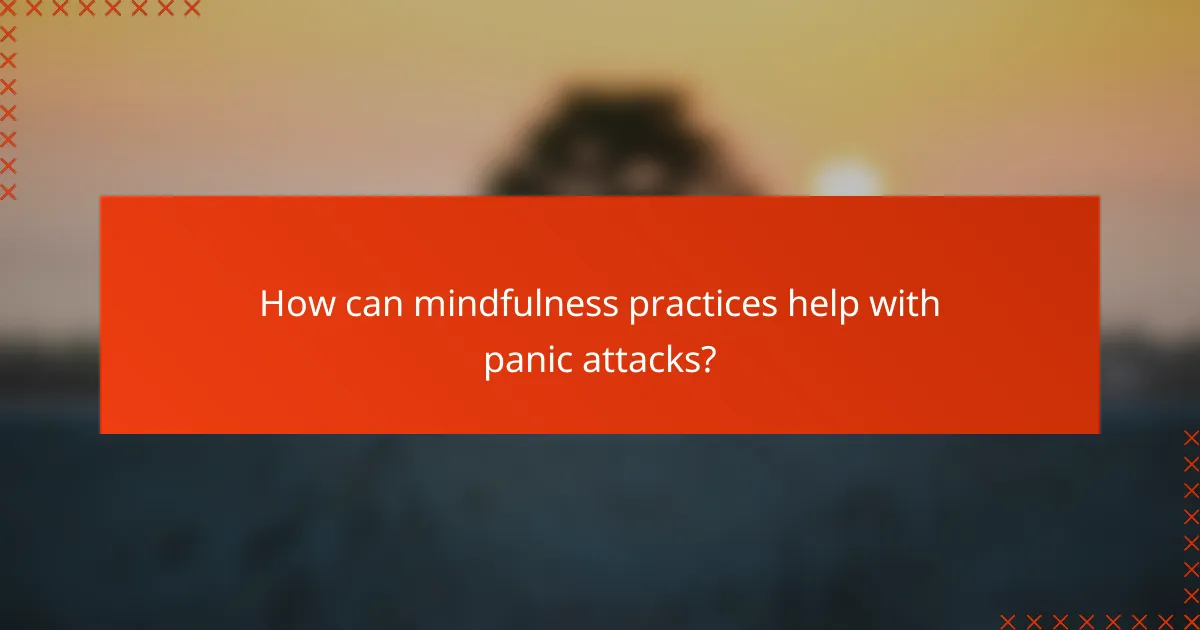
How can mindfulness practices help with panic attacks?
Mindfulness practices can significantly alleviate panic attacks by promoting relaxation and grounding individuals in the present moment. Techniques such as meditation, yoga, and focused breathing help reduce the intensity of anxiety symptoms and foster a sense of control during distressing episodes.
Reduces anxiety symptoms
Mindfulness practices are effective in lowering anxiety symptoms by encouraging individuals to focus on their breath and bodily sensations. Techniques like deep breathing and progressive muscle relaxation can help interrupt the cycle of panic by shifting attention away from overwhelming thoughts.
Engaging in mindfulness meditation for just a few minutes daily can lead to noticeable reductions in anxiety levels over time. Regular practice can help train the mind to respond more calmly to stressors, making panic attacks less frequent and intense.
Promotes emotional regulation
Mindfulness enhances emotional regulation by fostering a non-judgmental awareness of one’s thoughts and feelings. This awareness allows individuals to observe their emotional responses without becoming overwhelmed, which is crucial during a panic attack.
Practicing mindfulness techniques, such as yoga, can help individuals develop a greater ability to manage their emotions. By connecting breath with movement, individuals learn to respond to their feelings with more clarity and less reactivity, ultimately reducing the likelihood of panic episodes.
Enhances self-awareness
Mindfulness practices cultivate self-awareness, enabling individuals to recognize early signs of anxiety and panic. This heightened awareness can serve as an early warning system, allowing for timely intervention before a panic attack escalates.
Journaling or reflecting on experiences after mindfulness sessions can further enhance self-awareness. By identifying triggers and patterns, individuals can develop strategies to cope more effectively with anxiety, leading to improved mental health outcomes.
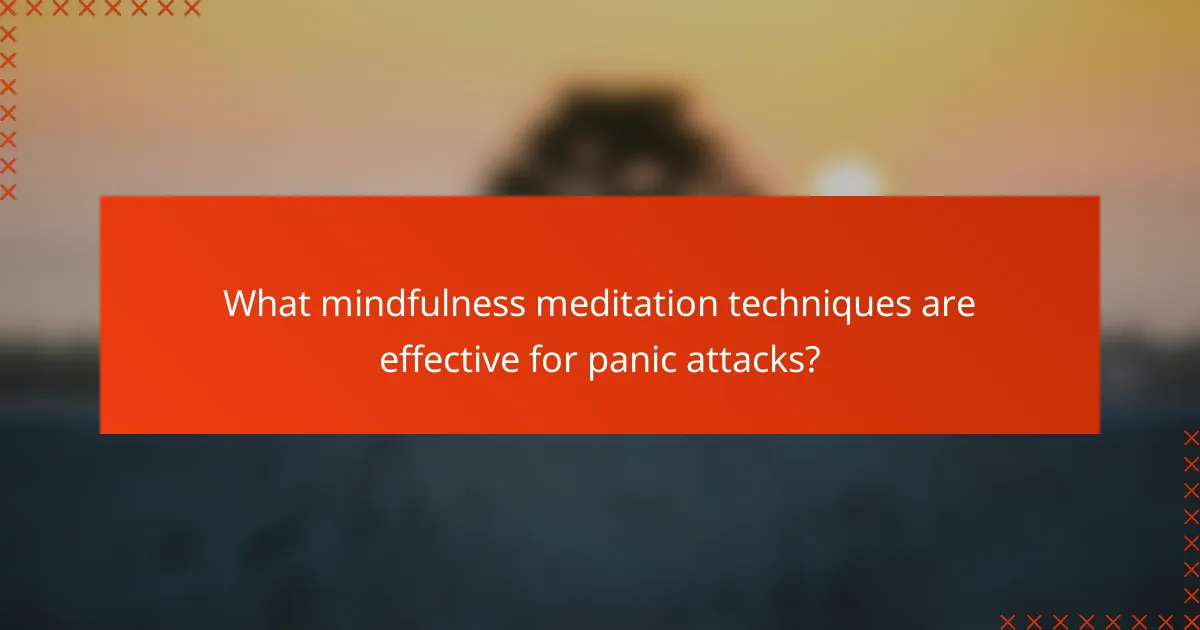
What mindfulness meditation techniques are effective for panic attacks?
Mindfulness meditation techniques can significantly help manage panic attacks by promoting relaxation and present moment awareness. Techniques such as guided meditation, body scan, and breath awareness are particularly effective in reducing anxiety and fostering a sense of calm.
Guided meditation apps
Guided meditation apps provide structured sessions led by experienced instructors, making them accessible for individuals experiencing panic attacks. Popular apps like Headspace and Calm offer specific programs designed to alleviate anxiety and promote mindfulness. Users can select sessions based on their needs, ranging from a few minutes to longer durations.
When using guided meditation apps, it’s important to find a quiet space where you can focus without distractions. Regular practice can enhance the effectiveness of these sessions, helping to build resilience against panic attacks over time.
Body scan meditation
Body scan meditation involves systematically focusing on different parts of the body to promote relaxation and awareness. This technique helps individuals identify areas of tension and release stress, which can be particularly beneficial during a panic attack. Sessions typically last between 10 to 30 minutes.
To practice body scan meditation, lie down comfortably and close your eyes. Begin by focusing on your toes, gradually moving up through your body to your head, paying attention to sensations and releasing tension as you go. This practice can help ground you in the present moment, reducing feelings of panic.
Breath awareness techniques
Breath awareness techniques focus on observing and controlling your breathing to induce calmness. Simple practices like deep breathing or counting breaths can help manage anxiety during a panic attack. Aim for a slow, steady rhythm, inhaling for a count of four, holding for four, and exhaling for six.
Incorporating breath awareness into your daily routine can enhance your ability to cope with panic attacks. Try to practice for a few minutes each day, especially during stressful situations, to build familiarity and effectiveness. Avoid shallow breathing, as it can exacerbate feelings of anxiety.
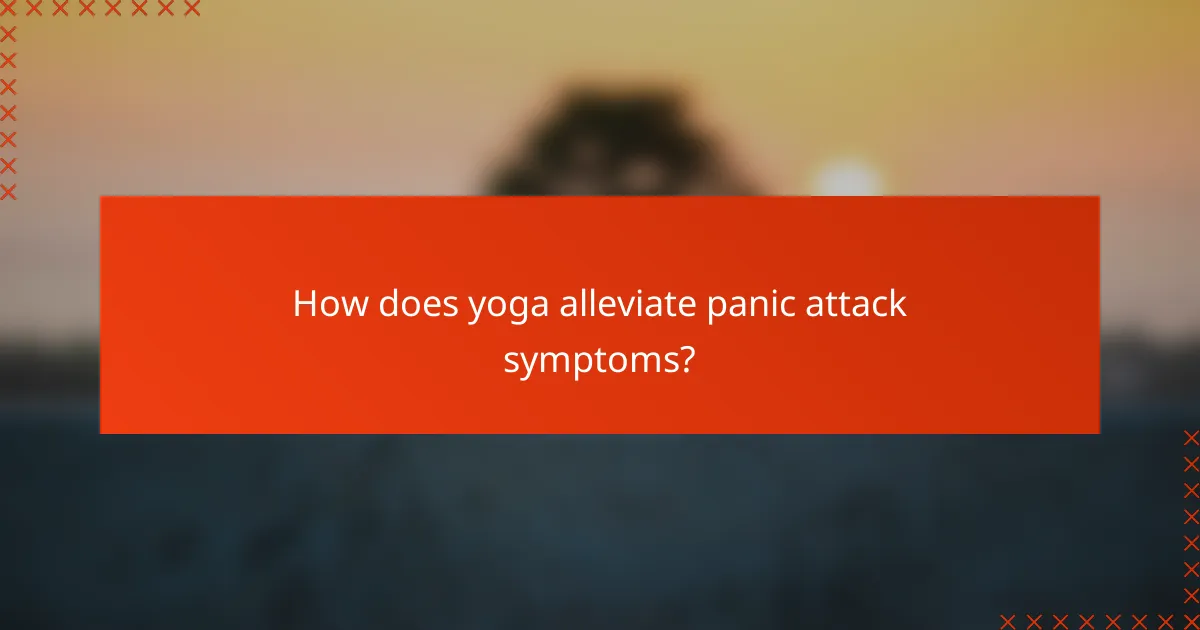
How does yoga alleviate panic attack symptoms?
Yoga alleviates panic attack symptoms by promoting relaxation, enhancing body awareness, and reducing stress. Through various techniques, yoga helps individuals manage their anxiety and regain a sense of control during panic episodes.
Restorative yoga poses
Restorative yoga poses focus on gentle stretching and relaxation, allowing the body to release tension. Poses such as Child’s Pose, Legs-Up-the-Wall, and Supported Bridge can be particularly effective in calming the nervous system. Practicing these poses for 10-15 minutes can create a soothing environment that helps mitigate panic symptoms.
When practicing restorative poses, use props like bolsters or blankets to support your body fully. This support encourages deep relaxation and can help you stay present, reducing feelings of panic.
Breath control in yoga
Breath control, or pranayama, is a fundamental aspect of yoga that helps regulate the body’s response to stress. Techniques such as diaphragmatic breathing and alternate nostril breathing can slow the heart rate and promote a sense of calm. Aim for 5-10 minutes of focused breath control to effectively manage anxiety during a panic attack.
To practice diaphragmatic breathing, sit or lie down comfortably, place one hand on your chest and the other on your abdomen, and inhale deeply through your nose, ensuring your abdomen rises more than your chest. This technique can help shift your focus away from panic and back to the present moment.
Mindful movement practices
Mindful movement practices in yoga involve being fully aware of your body and breath as you transition between poses. This awareness can ground you in the present, making it easier to cope with panic. Incorporating slow, deliberate movements can help you reconnect with your body and reduce anxiety levels.
Consider integrating a short flow of poses, such as Sun Salutations, while maintaining a focus on your breath. This practice not only enhances physical flexibility but also cultivates mental clarity, which can be beneficial during moments of panic.

What are the benefits of present moment focus during panic attacks?
Present moment focus can significantly alleviate the intensity of panic attacks by anchoring individuals in the here and now. This practice helps to reduce anxiety and fosters a sense of control, making it easier to navigate overwhelming feelings.
Increases grounding
Grounding techniques help individuals reconnect with their physical surroundings, which can be particularly beneficial during a panic attack. By focusing on tangible sensations, such as feeling the ground beneath their feet or the texture of an object, individuals can create a sense of stability. Simple exercises, like taking deep breaths and counting to five, can enhance this grounding effect.
Reduces racing thoughts
During panic attacks, racing thoughts can exacerbate feelings of anxiety and helplessness. Present moment focus encourages individuals to redirect their attention away from spiraling thoughts and back to their current environment. Techniques such as mindful breathing or repeating a calming phrase can help slow down mental activity and promote clarity.
Enhances sensory awareness
Focusing on the present moment heightens sensory awareness, allowing individuals to engage with their surroundings more fully. This can involve noticing the sounds, sights, and smells around them, which can distract from panic symptoms. Practicing mindfulness through activities like mindful walking or listening to soothing music can strengthen this awareness and provide comfort during distressing moments.
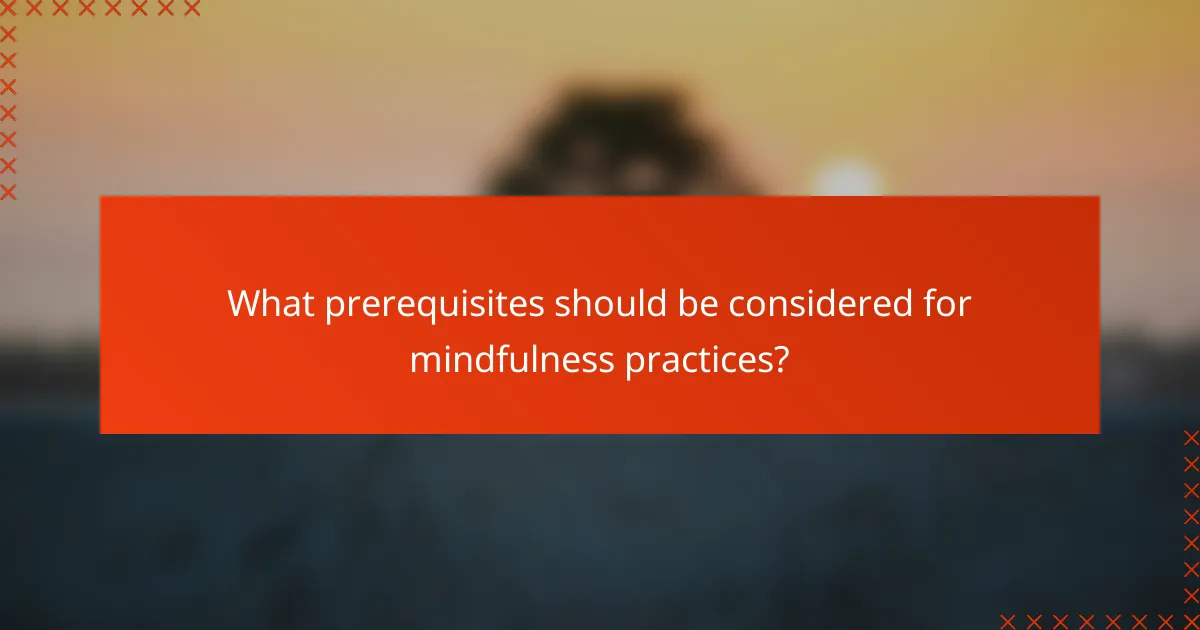
What prerequisites should be considered for mindfulness practices?
Before engaging in mindfulness practices for panic attacks, it’s essential to identify personal triggers and create a safe environment. Understanding these prerequisites can enhance the effectiveness of techniques like meditation and yoga.
Understanding personal triggers
Recognizing personal triggers is crucial for effectively managing panic attacks through mindfulness. Triggers can vary widely, including specific situations, thoughts, or physical sensations that provoke anxiety. Keeping a journal to track these triggers can help identify patterns and prepare for potential panic episodes.
Once triggers are identified, mindfulness practices can be tailored to address them. For instance, if crowded places trigger anxiety, practicing mindfulness in a quiet setting can build confidence before facing those environments. This gradual exposure can help desensitize the individual to their triggers over time.
Creating a safe environment
Establishing a safe environment is vital for practicing mindfulness effectively. This space should be free from distractions and evoke a sense of calm. Consider using soft lighting, comfortable seating, and soothing sounds to create an inviting atmosphere.
Additionally, ensure that the environment is physically safe, allowing for unrestricted movement during practices like yoga. Having a designated area for mindfulness can signal to the mind that it’s time to relax and focus, making it easier to engage in meditation or present moment awareness.

How can one integrate mindfulness into daily life for panic attack prevention?
Integrating mindfulness into daily life can significantly help prevent panic attacks by promoting relaxation and present-moment awareness. Simple practices such as meditation and mindful routines can reduce anxiety and enhance emotional regulation.
Daily meditation schedule
Establishing a daily meditation schedule can be a powerful tool for managing anxiety and preventing panic attacks. Aim for at least 10-20 minutes of meditation each day, ideally at the same time to create a habit. Morning sessions can set a calm tone for the day, while evening meditations can help unwind and prepare for restful sleep.
Consider using guided meditation apps or online resources to explore different techniques, such as breath awareness or body scans. Experiment with various styles to find what resonates best with you, and gradually increase the duration as you become more comfortable.
Incorporating mindfulness in routine activities
Mindfulness can be seamlessly integrated into everyday activities to enhance awareness and reduce stress. Practice being fully present during routine tasks, such as eating, walking, or even washing dishes. Focus on the sensations, sounds, and movements involved in these activities to cultivate a mindful mindset.
Additionally, set reminders throughout the day to pause and take a few deep breaths. This simple practice can help ground you in the present moment, making it easier to manage anxiety and prevent panic attacks. Consider using visual cues, like sticky notes or phone alerts, to prompt these mindful moments.
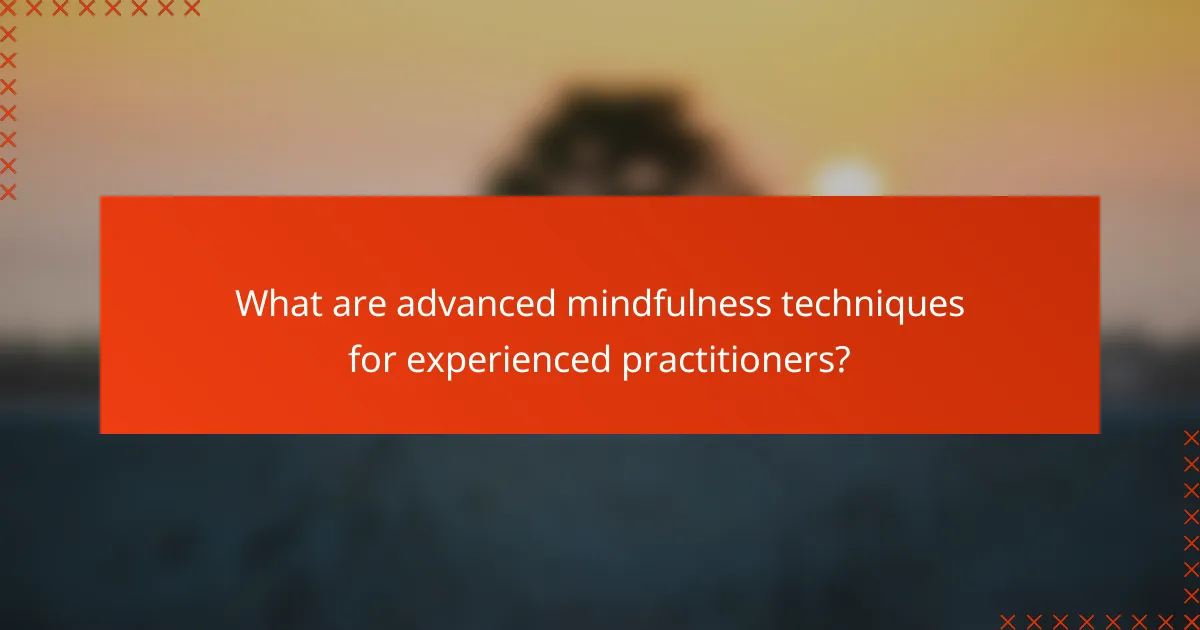
What are advanced mindfulness techniques for experienced practitioners?
Advanced mindfulness techniques for experienced practitioners include deeper meditation practices, specialized yoga styles, and enhanced focus on the present moment. These methods aim to cultivate a greater awareness of thoughts and emotions, helping to manage panic attacks more effectively.
Meditation Techniques
Experienced practitioners can explore techniques such as loving-kindness meditation or body scan meditation. Loving-kindness meditation focuses on generating feelings of compassion towards oneself and others, which can reduce anxiety and promote emotional resilience.
Body scan meditation involves systematically focusing on different parts of the body, helping to develop a heightened awareness of physical sensations and emotional states. Practicing these techniques regularly can enhance one’s ability to remain calm during panic attacks.
Yoga Practices
Advanced yoga practices like Kundalini or Yin Yoga can be beneficial for managing panic attacks. Kundalini yoga incorporates breath control, chanting, and movement, which can help release stored tension and promote relaxation.
Yin Yoga focuses on deep stretching and holding poses for extended periods, encouraging mindfulness and introspection. Both styles can create a sense of grounding and stability, making it easier to navigate moments of panic.
Present Moment Focus
To enhance present moment focus, experienced practitioners can utilize techniques such as mindful walking or sensory awareness exercises. Mindful walking involves paying attention to each step and the sensations in the body, which can help anchor the mind in the present.
Sensory awareness exercises encourage individuals to engage their senses fully, such as noticing the colors, sounds, and textures in their environment. This practice can effectively divert attention from panic triggers and foster a sense of calm.



